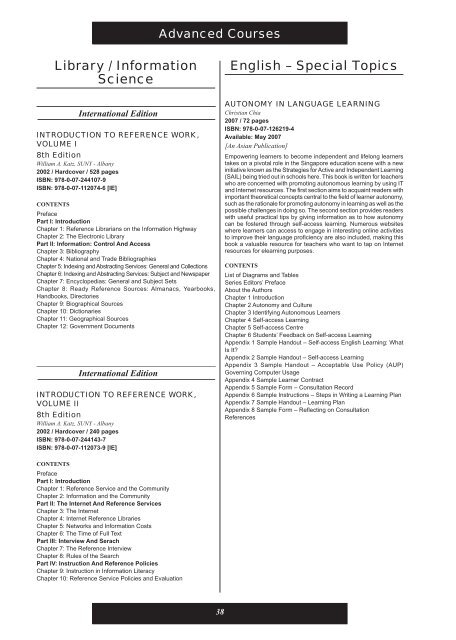ENGLISH - McGraw-Hill Books
ENGLISH - McGraw-Hill Books
ENGLISH - McGraw-Hill Books
Create successful ePaper yourself
Turn your PDF publications into a flip-book with our unique Google optimized e-Paper software.
Advanced CoursesLibrary / InformationScienceEnglish – Special TopicsInternational EditionINTRODUCTION TO REFERENCE WORK,VOLUME I8th EditionWilliam A. Katz, SUNY - Albany2002 / Hardcover / 528 pagesISBN: 978-0-07-244107-9ISBN: 978-0-07-112074-6 [IE]CONTENTSPrefacePart I: IntroductionChapter 1: Reference Librarians on the Information HighwayChapter 2: The Electronic LibraryPart II: Information: Control And AccessChapter 3: BibliographyChapter 4: National and Trade BibliographiesChapter 5: Indexing and Abstracting Services: General and CollectionsChapter 6: Indexing and Abstracting Services: Subject and NewspaperChapter 7: Encyclopedias: General and Subject SetsChapter 8: Ready Reference Sources: Almanacs, Yearbooks,Handbooks, DirectoriesChapter 9: Biographical SourcesChapter 10: DictionariesChapter 11: Geographical SourcesChapter 12: Government DocumentsInternational EditionINTRODUCTION TO REFERENCE WORK,VOLUME II8th EditionWilliam A. Katz, SUNY - Albany2002 / Hardcover / 240 pagesISBN: 978-0-07-244143-7ISBN: 978-0-07-112073-9 [IE]AUTONOMY IN LANGUAGE LEARNINGChristian Chia2007 / 72 pagesISBN: 978-0-07-126219-4Available: May 2007[An Asian Publication]Empowering learners to become independent and lifelong learnerstakes on a pivotal role in the Singapore education scene with a newinitiative known as the Strategies for Active and Independent Learning(SAIL) being tried out in schools here. This book is written for teacherswho are concerned with promoting autonomous learning by using ITand Internet resources. The first section aims to acquaint readers withimportant theoretical concepts central to the field of learner autonomy,such as the rationale for promoting autonomy in learning as well as thepossible challenges in doing so. The second section provides readerswith useful practical tips by giving information as to how autonomycan be fostered through self-access learning. Numerous websiteswhere learners can access to engage in interesting online activitiesto improve their language proficiency are also included, making thisbook a valuable resource for teachers who want to tap on Internetresources for elearning purposes.CONTENTSList of Diagrams and TablesSeries Editors’ PrefaceAbout the AuthorsChapter 1 IntroductionChapter 2 Autonomy and CultureChapter 3 Identifying Autonomous LearnersChapter 4 Self-access LearningChapter 5 Self-access CentreChapter 6 Students’ Feedback on Self-access LearningAppendix 1 Sample Handout – Self-access English Learning: WhatIs It?Appendix 2 Sample Handout – Self-access LearningAppendix 3 Sample Handout – Acceptable Use Policy (AUP)Governing Computer UsageAppendix 4 Sample Learner ContractAppendix 5 Sample Form – Consultation RecordAppendix 6 Sample Instructions – Steps in Writing a Learning PlanAppendix 7 Sample Handout – Learning PlanAppendix 8 Sample Form – Reflecting on ConsultationReferencesCONTENTSPrefacePart I: IntroductionChapter 1: Reference Service and the CommunityChapter 2: Information and the CommunityPart II: The Internet And Reference ServicesChapter 3: The InternetChapter 4: Internet Reference LibrariesChapter 5: Networks and Information CostsChapter 6: The Time of Full TextPart III: Interview And SerachChapter 7: The Reference InterviewChapter 8: Rules of the SearchPart IV: Instruction And Reference PoliciesChapter 9: Instruction in Information LiteracyChapter 10: Reference Service Policies and Evaluation38

















